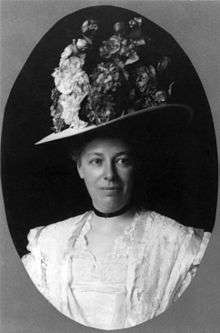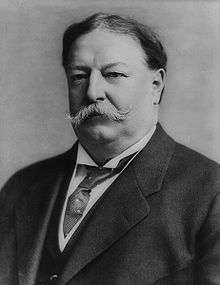Helen Herron Taft
Helen Louise "Nellie" Taft (née Herron; June 2, 1861 – May 22, 1943) was the wife of William Howard Taft and the First Lady of the United States from 1909 to 1913.
Hellen Herron Taft | |
|---|---|
 | |
| First Lady of the United States | |
| In role March 4, 1909 – March 4, 1913 | |
| President | William Taft |
| Preceded by | Edith Roosevelt |
| Succeeded by | Ellen Wilson |
| Personal details | |
| Born | Helen Louise Herron June 2, 1861 Cincinnati, Ohio, U.S. |
| Died | May 22, 1943 (aged 81) Washington, D.C., U.S. |
| Resting place | Arlington National Cemetery |
| Spouse(s) | |
| Children | Robert Helen Charles |
| Education | University of Cincinnati |
| Signature | |
Early years
Born in Cincinnati, Ohio, Nellie was the fourth of eleven children of Judge John Williamson Herron (1827–1912), a college classmate of Benjamin Harrison and a law partner of Rutherford B. Hayes. Her mother, Harriet Collins Herron (1833–1902), was the daughter and the sister of U.S. congressmen;[1] Nellie's grandfather, Ela Collins, and uncle, William Collins, were both members of Congress. During her childhood she was called Nellie rather than Helen; she was referred to as such in the family since her only daughter was named Helen. Nellie Herron was enrolled in private Miss Nourse School, known in Cincinnati as The Nursery, in 1866–1879, and took classes from the University of Cincinnati. Starting from 1882, she taught in different schools until her marriage. In 1877, she attended with her parents the twenty-fifth wedding anniversary celebration of President and Mrs. Rutherford B. Hayes and stayed for a week at the White House.[2] Her younger sister Lucy Hayes Herron was baptized at that event and named for Mrs. Hayes.[3][4]
In 1879, she met William Howard Taft at a bobsledding party in Cincinnati; he was 22 years old, she was 18. He asked her out for the first time in February 1880, but they did not go out regularly until 1882. He proposed in April 1885, and she accepted in May.
Marriage
Taft married Nellie on June 19, 1886, at the home of the bride's parents in Cincinnati. The wedding was performed by the Reverend D.N.A. Hoge of Zanesville, Ohio. Taft's younger brother Horace Taft was the best man. The couple honeymooned one day in New York City and four days at Sea Bright, New Jersey, before setting off on a three-month tour of Europe.
On their return, they settled in Cincinnati. Nellie Taft encouraged her husband's political career despite his often-stated preference for the judiciary. However, she welcomed each step in his judicial career: state judge, Solicitor General of the United States, and federal circuit court judge. In 1900, Taft agreed to take charge of American civil government in the Philippines as Governor-General (1900-1903). Nellie Taft moved with their children to Manila where she tried to reconcile with the local population by showing respect to the culture of the Philippines by learning the language, wearing a native Filipino costume and inviting Filipinos to social events.[5] Further travel with her husband, who became Secretary of War in 1904, brought a widened interest in world politics and a cosmopolitan circle of friends.[6]
Family
The Tafts had two sons and a daughter. Robert A. Taft (1889–1953) was a politician and statesman, Helen Taft Manning (1891–1987) was an educator, and Charles Phelps Taft II (1897–1983) was a civic leader.
First Lady of the United States

Nellie Taft was the first First Lady to ride in her husband's inauguration parade, which she did despite adverse weather. She started to receive guests three afternoons a week in the Red Room. At times, she attended the cabinet meetings with the President without speaking on the issues. She introduced musical entertainment after state dinners which became a White House tradition. The Tafts attended symphony, opera, and theater performances in Washington D.C.; she started another summer tradition at West Potomac Park with the United States Marine Band playing for the public.[6]
In May 1909, Nellie Taft suffered a stroke, impairing her speech, right arm and leg. The stroke happened at the beginning of her husband's presidential term.[7] Assisted by her four sisters, she continued her functions as White House host until she recovered with the help of her husband.[8]
The social highlight of the Taft administration was the Tafts' silver wedding anniversary gala on June 19, 1911, for some 2,000 guests.[8]
In her most lasting contribution as First Lady, Nellie Taft arranged for the planting of the 3,020 Japanese cherry trees around the Tidal Basin and on Capitol grounds; with the wife of the Japanese ambassador, she personally planted the first two saplings in ceremonies on March 27, 1912.[9]
The First Lady notably enjoyed the company of Vice President James S. Sherman and his wife Carrie; this encouraged a more harmonious working relationship between the President and Vice President, who had earlier found themselves at odds.
.png)
In June 1912, she attended both the Republican National Convention that re-nominated her husband and the Democratic National Convention that nominated his opponent Woodrow Wilson. She took a front-row seat at the latter in order to deter speakers' criticism of her husband.[10] After losing the election, the Tafts returned to Cincinnati, where William began teaching law. Nellie Taft wrote her memoir, Recollections of Full Years, which was published in 1914. During the Great War, she provided support for the American Red Cross.
With Taft's appointment to the Supreme Court in 1921, Nellie Taft became the only woman to be both First Lady and wife of a chief justice. She resumed her social activities after returning to Washington D.C.
Prohibition was a major political debate at the time. Nellie Taft was a Wet (an opponent of the Prohibition movement), so White House guests were entertained with alcohol during her time as First Lady. William Howard Taft opposed Prohibition during his presidency and much of his time as Chief Justice, but was himself a teetotaler and during his last years wrote letters in support of Prohibition's objectives.[11]
Nellie Taft was the first First Lady to publish her memoirs, the first First Lady to own and drive a car, the first First Lady to support women's suffrage, the first First Lady to smoke cigarettes, and the first First Lady to successfully lobby for safety standards in federal workplaces. She was also the first First Lady to follow her husband in the inauguration parade.[12]
Nellie Taft was widowed upon the death of her husband on March 8, 1930, and stayed in the city of Washington. She continued to be socially involved serving as an honorary vice president of the Colonial Dames of America and the Girl Scouts of the USA.[6] She died in Washington, D.C. on May 22, 1943, and was buried next to the President at Arlington National Cemetery which created a precedent later used for Jacqueline Kennedy.
References
- First Lady Biography: Helen Taft, The National First Ladies' Library
- Taft, Helen H. Recollections of Full Years. New York: Dodd, Mead & Co, 1914.
- Anderson, Greta (2015-11-01). Ohio's Remarkable Women: Daughters, Wives, Sisters, and Mothers Who Shaped History. Rowman & Littlefield. p. 83. ISBN 9781493016754.
- Waldrup, Carole Chandler (2016-04-06). Wives of the American Presidents, 2d ed. McFarland. pp. 124–125. ISBN 9781476605166.
- Hendricks, Nancy. America's First Ladies: A Historical Encyclopedia and Primary Document Collection of the Remarkable Women of the White House. ABC-CLIO, 2015.
- Stacy A. Cordery. Taft, Helen Herron. American National Biography Online, February 2000. Retrieved January 2, 2016,
- Cook, Blanche Wiesen (1999). Eleanor Roosevelt, Vol. 2: 1933–1938. Viking. p. 17. ISBN 9780670844982.
- Lindsay, Rae. The Presidents' First Ladies. New York: F. Watts, 1989, p. 197.
- Cooper, Rachel. Washington, DC’s Cherry Trees - Frequently Asked Questions. About.com. Accessed November 27, 2012.
- Anthony, Carl. "Nellie Taft's Unprecedented Appearance at a National Convention". National First Ladies' Library. Archived from the original on 21 March 2016. Retrieved 16 February 2016.
- "PROHIBITION: Taft Conversion". Time. March 31, 1930.
- "Little-known facts about our First Ladies". Firstladies.org. Retrieved 2015-07-07.
Further reading
- Taft, Helen H. Recollections of Full Years. New York: Dodd, Mead & Co, 1914.
External links
| Wikimedia Commons has media related to Helen Herron Taft. |
- Works by or about Helen Herron Taft at Internet Archive
- Helen Herron Taft at Find a Grave
- Helen Herron Taft White House biography
- Helen Taft at C-SPAN's First Ladies: Influence & Image
| Honorary titles | ||
|---|---|---|
| Preceded by Edith Roosevelt |
First Lady of the United States 1909–1913 |
Succeeded by Ellen Wilson |

